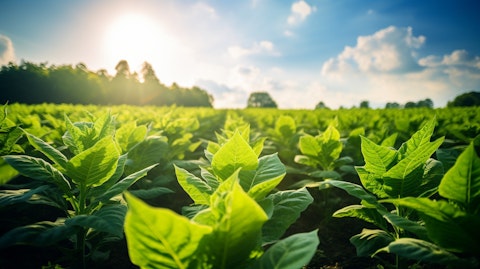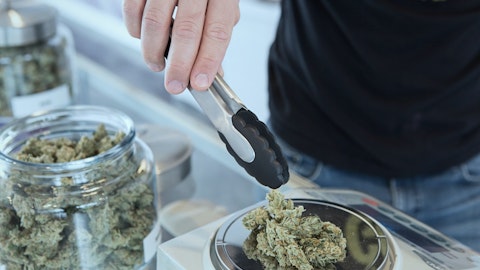Universal Corporation (NYSE:UVV) Q2 2024 Earnings Call Transcript November 2, 2023
Operator: Good afternoon, ladies and gentlemen, and welcome to the Universal Corporation Second Quarter Fiscal Year 2024 Earnings Conference Call. [Operator Instructions] This call is being recorded, Thursday, November 2, 2023. And I would now like to turn the conference over to Ms. Jennifer Rowe, AVP of Capital Markets. Thank you. Please go ahead.
Jennifer Rowe: Thank you for joining us. George Freeman, our Chairman, President and CEO; Airton Hentschke, our Chief Operating Officer; and Johan Kroner, our Chief Financial Officer, are here with me today and will join me in answering questions after these brief remarks. This call is being webcast live and will be available on our website and on telephone taped replay. It will remain on our website through February 2, 2024. Other than the replay, we have not authorized and disclaim responsibility for any recording, replay or distribution of any transcription of this call. This call is copyrighted and may not be used without our permission. Before I begin to discuss our results, I caution you that we will be making forward-looking statements that are based on our current knowledge and some assumptions about the future and are representative as of today only.
Actual results could differ materially from projected or estimated results, and we assume no obligation to update any forward-looking statements. For information on some of the factors that can affect our estimates, I urge you to read our 10-K for the year ended March 31, 2023. Such risks and uncertainties include, but are not limited to, impacts of pandemic, customer-mandated timing of shipments, weather conditions, political and economic environment, government regulation and taxation, changes in exchange rates and interest rates, industry consolidation and evolution and changes in market structure or sources. Finally, some of the information I have for you today is based on unaudited allocation and is subject to reclassification. In an effort to provide useful information to investors, our comments today may include non-GAAP financial measures.
For details on these measures, including reconciliations to the most comparable GAAP measures, please refer to our current earnings press release. Our fiscal year 2024 is developing very well with operating income for the six months and quarter ended September 30, 2023, up 30% and 46%, respectively, compared to the six months and quarter ended September 30, 2022. Gross profit margins also rebounded nicely in the first half of fiscal year 2024 compared to the same period in fiscal year 2023 with our Ingredients companies making a positive contribution. Our Tobacco Operations segment delivered strong performance in the first half of fiscal year 2024 on robust demand for leaf tobacco from our customers. Results for the Ingredients Operations segment were also up in the second quarter of fiscal year 2024 compared to the same quarter in the prior fiscal year.
The segment saw some supply chain normalization, which stabilized demand from certain of our customers and generated better results in the second quarter of fiscal year 2024 compared to the first quarter of 2024 when the segment experienced soft customer demand. Strong demand for leaf tobacco from our customers and a favorable tobacco product mix benefited our results for the first half of fiscal year 2024. Leaf tobacco margins improved in the first half of fiscal year 2024 despite lower lease tobacco sales volumes as we had fewer shipments of lower-margin tobacco compared to the first half of fiscal year 2023. Segment operating income for our Tobacco Operations segment was up 46% and 55% for the six months and the quarter ended September 30, 2023, respectively compared to the six months and quarter ended September 30, 2022.

Our uncommitted tobacco inventory level of 12% at September 30, 2023, remained low and global leaf tobacco supply continues to be tight for all types of tobacco. Looking ahead, we continue to expect that similar to fiscal year 2023, our tobacco shipments will be strongly weighted to the second half of fiscal year 2024. We also believe our uncommitted tobacco inventory levels remain low for the rest of fiscal year 2024. We were pleased to see demand from certain customers for our Ingredients products stabilizing in the quarter ended September 30, 2023. Although results for the Ingredients Operations segment were lower in the six months ended September 30, 2023, compared to the six months ended September 30, 2022, we believe that our customers have been working through their excess inventory levels and raw material prices such as apple prices are coming down.
While navigating evolving market dynamics, we remain focused on and encouraged by both our poor and new business opportunities with existing and first-time Ingredients customers. We continue to strongly believe that our commercial and research and development efforts coupled with our expanded range of capabilities that we can offer our customers due to our ongoing investments in our Ingredients platform will strengthen our business for the future. Some financial highlights for the six months ended September 30, 2023. Net income for the six months was $26.1 million or $1.04 per diluted share. Excluding certain nonrecurring items detailed in today’s earnings press release, net income increased by $0.2 million and diluted earnings per share were flat for the six months ended September 30, 2023, compared to the six months ended September 30, 2022.
Operating income of $66.3 million for the six months ended September 30, 2023, increased by $15.2 million. Segment operating income for the Tobacco Operations segment was up $19.4 million, while segment operating income for the Ingredients Operations segment was down $6.3 million for the six months ended September 30, 2023 compared to the six months ended September 30, 2022. Selling, general and administrative expenses were up $10.5 million in the first half of fiscal year 2024 compared to the first half of fiscal year 2023. Some financial highlights for the quarter ended September 30, 2023. Net income for the quarter was $28.1 million or $1.12 per diluted share. Excluding certain nonrecurring items detailed in today’s press release, net income and diluted earnings per share increased by $8.4 million and $0.33, respectively for the quarter ended September 30, 2023, compared to the quarter ended September 30, 2022.
Operating income of $55.3 million for the quarter increased by $17.4 million. Segment operating income for the Tobacco Operations segment was up $18.6 million and segment operating income for the Ingredients segment was up $0.3 million for the quarter ended September 30, 2023 compared to the quarter ended September 30, 2022. Our costs continue to be elevated in the first half of fiscal year 2024 compared to the first half of fiscal year 2023. Interest expense was up over $13 million, primarily on higher interest rates and green tobacco prices were also higher. Despite the higher cost, we have been able to reduce our debt levels in fiscal year 2024. At September 30, 2023, our net debt levels which we define as the sum of notes payable and overdrafts, long-term debt and customer bands and deposits, less cash and cash equivalents declined by about $70 million compared to our net debt levels at September 30, 2022.
Universal has a fundamental responsibility to its stakeholders to achieve high standards of environmental performance to support sustainable operations which we demonstrate through our supplier engagement and disclosures on Climate Change, Water Stewardship and Forestry. Our record is highlighted by 15 years of participation in CDP disclosure, the establishment of science-based targets and recognition by CDP as a Supplier Engagement Leader. To add to our commitment to environmental sustainability, we have committed to Water Stewardship throughout our operations. To Universal, Water Stewardship is water usage that is socially and culturally equitable, environmentally sustainable, economically beneficial and achieved through a multi-stakeholder process.
Our Nominating and Corporate Governance Committee and our management team have approved a Water Stewardship Policy to guide and publicly commit to Water Stewardship through our global operations. At this time, we are available to take your questions.
See also 20 Countries With Highest Cost of Education and 20 Most Consumed Fruit in the US.
Q&A Session
Follow Universal Corp (NYSE:UVV)
Follow Universal Corp (NYSE:UVV)
Receive real-time insider trading and news alerts
Operator: [Operator Instructions] Your first question comes from the line of Ann Gurkin from Davenport & Co. Please go ahead.
Ann Gurkin: Good evening to everybody. It was nice to see your debt reduction in the quarter and you bought back shares. I was wondering if you could help me how to think about both of those measures for the back half and within that conversation, expected working capital needs for the full year?
Johan Kroner: Yes. And I think that certainly, with regard to debt, we are looking at monetizing the sales that we have. We’re still have inventory that we expect to ship quite a bit of during the latter half of the year, receivables. And of course, all — so we hope that debt to be down later this year. With regard to the stock buyback, that is something that we need to do to take out the dilution with regard to the comp for executives.
Ann Gurkin: Okay. And then it looks like the CapEx was trimmed a little bit, $60 to $70 versus the prior $65, $75, is there anything in that, I should know about?
Johan Kroner: At the end of the day, that is purely a bit of a shift there with regard to the ingredients expansion that we’re doing in Lancaster, Pennsylvania. We were hoping that, that number would come down faster, but we’re thinking that 60 to 70 is the right range for the next 12 months.
Ann Gurkin: Okay. Switching to tobacco. You referenced in the comments that customer demand — demand for leaf remains strong from customers. I guess can you reconcile the latest domestic cigarette industry volume dropped of low double digits? And the path that large customers on to generate two-thirds of the revenues from smoke-free tobacco shift in kind of both of those metrics and how you are working on your leaf supply-demand balance over the next two, three, five years? Any kind of comments you can share?
Airton Hentschke: Yes. First of all, the U.S. domestic market represents less than 5% of the overall market in China and every customers here, we have relationships and every customer is important that we continue supplying services and product here. With regards to the demand, yes, we continue seeing a strong demand for our portfolio of products, different varieties of tobacco. We stated that we see undersupply basically in every one of these categories, and we believe that it will continue into the next year. So with regards as new generation products, as I stated also before, we basically participate in all these categories as well as supplying service and raw products for the heat-not-burn, for the vaping, shisha, smokeless, oral products, and that is why — how we see it that we continue seeing opportunities in all the segments where we operate.
Ann Gurkin: And in the latest lease market update, it looks like expected crop production in South America was reduced for both for cured and burley. Can you help me understand what’s going on with those crops?
Airton Hentschke: Yes. What we are facing this year is El Nino phenomenon. The El Nino affects agriculture in general and is not different for tobacco. And the phenomenon is about warmer waters are pushed closer to the Eastern Coast of the Americas, so producing excessive or above average rainfall in South of Brazil where tobacco is produced. We see an opposite phenomenon in Africa where the El Nino there means a dryer and a warmer environment. What is important here also, Ann, is that as we knew that, that phenomenon was building up at the beginning of the year, we are proactively working with our leaf technicians and agronomy team that are working with our pharma base to mitigate some of these effects. So just for example, we issue additional — or we are growing additional seedlings to make sure that we have — our pharma base have enough material to replace some of the losses that they are facing, also positioning ourselves with having additional fertilizer to supply for the farmers and also working with them or anticipating or delaying the transplanting season.




